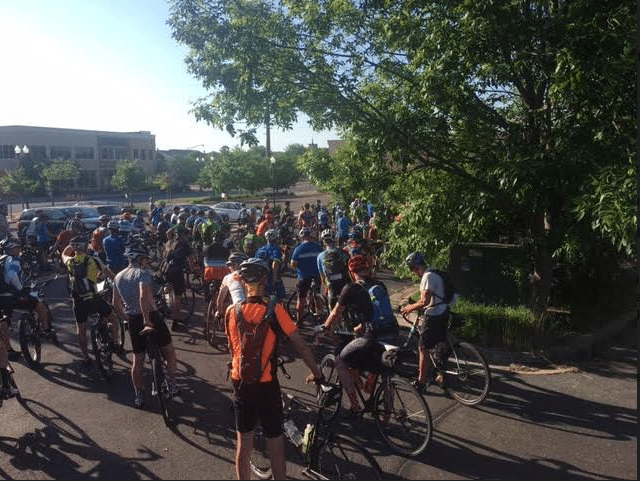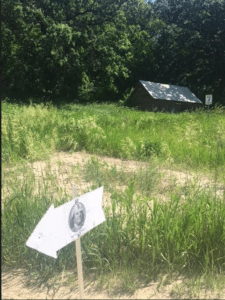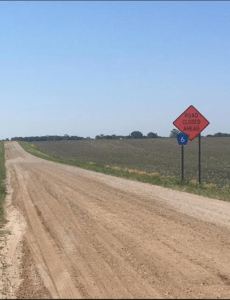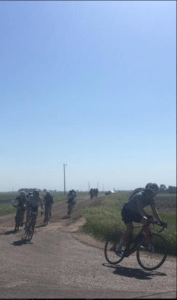<Back to News Home |
Showing Up, Weather Be Damned – by John Ingham – Images by Jenny Stukel
Weather extremes are posing challenges for racers and sometimes for race organizers. No-shows can put races in the red when financing depends on donations and raffle tickets, and races can turn into epic struggles for riders who do show up.

Adversity is not necessarily a good reason for withdrawing, however. Gravel riding never was about comfort, and there is something to be said for struggle, including epic struggle. Moreover, there are strategies for staying strong and safe in rough weather.
 Winds at 20 mph gusting to 35 mph and a 100 degree heat index were predicted for the 2017 Westside Dirty Benjamin. Although roughly 350 riders were expected, only 160 started and just 98 racers finished. I considered withdrawing but decided to show up when Jason (the WDB director) added shorter versions of the 100-mile course—I figured I could battle the wind for a few hours and then ride it back to the starting line. I finished the 76-mile course, with a few navigation-confused extra miles thrown in for good measure, but it was far from easy even with the second-half tailwind. Besides the extreme heat and strong headwinds, in the early going there were long stretches of fresh, tire-grabbing sand. When I asked my friend Trenton Raygor how it went for him, he emailed, “Yesterday was hell. It was incredibly humbling” (he rode the 100 miles on a single speed!). Jason says two of the top finishers found the race more difficult than this year’s Dirty Kanza. The 2017 WDB courses were beautiful and interesting and would have been a pleasure in any weather, but as perverse as it may seem, the challenges only made them more appealing, not less. Trenton hints as much. He also describes the race as “character building at its finest.” I will let others speak to any improvements in my character, but I am pleased to say that I enjoyed the race. I even enjoyed the misery. And it put me in an unusually good mood for days. How can that be? And what can one do to prepare for such an ordeal?
Winds at 20 mph gusting to 35 mph and a 100 degree heat index were predicted for the 2017 Westside Dirty Benjamin. Although roughly 350 riders were expected, only 160 started and just 98 racers finished. I considered withdrawing but decided to show up when Jason (the WDB director) added shorter versions of the 100-mile course—I figured I could battle the wind for a few hours and then ride it back to the starting line. I finished the 76-mile course, with a few navigation-confused extra miles thrown in for good measure, but it was far from easy even with the second-half tailwind. Besides the extreme heat and strong headwinds, in the early going there were long stretches of fresh, tire-grabbing sand. When I asked my friend Trenton Raygor how it went for him, he emailed, “Yesterday was hell. It was incredibly humbling” (he rode the 100 miles on a single speed!). Jason says two of the top finishers found the race more difficult than this year’s Dirty Kanza. The 2017 WDB courses were beautiful and interesting and would have been a pleasure in any weather, but as perverse as it may seem, the challenges only made them more appealing, not less. Trenton hints as much. He also describes the race as “character building at its finest.” I will let others speak to any improvements in my character, but I am pleased to say that I enjoyed the race. I even enjoyed the misery. And it put me in an unusually good mood for days. How can that be? And what can one do to prepare for such an ordeal?
[adrotate group=”1″]
At their heart, gravel riding and racing are all about struggle with adversity, which is surely why they are so rewarding and satisfying, odd though that may seem to the average couch potato. Sarah Cooper wrote this after failing to finish Trans Iowa despite a noble effort:
But then Luke asked if I was sending in a post card again, and I said yes. My coach likes to remind me periodically that a life not lived is no way to live, and too much living is no way to die. I’m a 45-Year- old amateur athlete. This is my life, I’m driven to live it, and sometimes I ride the line. People always ask me why. I don’t know why. Why are some people so tame, content to get through their workday and have a drink and watch TV, have a socially acceptable number of children, ride the bike trail always, and take their vacations relaxing on a beach? Why?
 Similar passages occur throughout the endurance and adventure sport literature. They testify to satisfaction to be found in coping with adversity and pushing limits. In this respect, gravel may be a microcosm of what’s good for us. A while back an article in “Psychology Today” observed that ordinary pleasure and comfort are overrated. A truly good life, it claimed, “requires a messy battle with adversity” (Kat McGowan, “The Hidden Side of Happiness,” 2006). Dealing with adversity is character building. And despite the suffering, in controlled doses the adversity we experience in our outdoor adventures can lead to happiness and inspiration bordering on what some might regard as states of grace. As Doug Robinson shows in his “The Alchemy of Action” (Moving Over Stone, 2013), fear and severe effort during endurance and adventure sports regularly promote heightened perception and unusual serenity.
Similar passages occur throughout the endurance and adventure sport literature. They testify to satisfaction to be found in coping with adversity and pushing limits. In this respect, gravel may be a microcosm of what’s good for us. A while back an article in “Psychology Today” observed that ordinary pleasure and comfort are overrated. A truly good life, it claimed, “requires a messy battle with adversity” (Kat McGowan, “The Hidden Side of Happiness,” 2006). Dealing with adversity is character building. And despite the suffering, in controlled doses the adversity we experience in our outdoor adventures can lead to happiness and inspiration bordering on what some might regard as states of grace. As Doug Robinson shows in his “The Alchemy of Action” (Moving Over Stone, 2013), fear and severe effort during endurance and adventure sports regularly promote heightened perception and unusual serenity.
Rather than withdrawing on bad weather days, it might be better to ratchet up one’s courage and give it a try. Okay you may say, but how do we do that? Part of an answer may lie in how we view adversity. Tommy Caldwell is one of the best rock climbers in the world, an authentic badass. Sitting out a blizzard high on the sheer face of El Capitan in Yosemite while working on the unbelievably difficult free ascent of the Dawn Wall, he remarked, “I don’t know why I love this shit so much, but I do” (or something to that effect). From the time he was a little boy, Tommy’s dad taught him to regard adversity as opportunity for adventure. See “Tommy Caldwell, The Push: A Climber’s Journey of Endurance, Risk, and Going Beyond Limits” (Viking, 2017). Tommy’s dad was on to something. Whether we think negatively or positively about stressful situations influences whether they are bad or good for us. It also determines how well we perform (NYTs).
Throughout the 2017 WDB I made a conscious effort to enjoy the day. That helped me keep going, but by itself it would not have been enough to get me through the race. Other things also helped, not the least of which was the company of other riders.
Heat Management and Camaraderie. I started hydrating for the Westside Dirty Benjamin the day before and drank over 30 ounces of water a couple of hours before the race. During the race, I drank more than 200 ounces of water. Most of my water contained added electrolytes, but not a lot of salt. I drank when thirsty but I did not force the water. Too much water and salt can be as harmful as too little (Hammer Nutrition).
Before the race I filled my Camelbak with ice. For the first couple of hours I drank from water bottles while the ice cooled my backside. Other riders helped with hydration. Approaching Henderson, Derek and Luke had us pilfering water from a backyard hose (dousing myself with the cold water was like having a re-start button). While riding with another group through Belle Plaine, Mike shared his Gator Aid with me and Lynn spotted a park where we were able to fill water bottles and I was able to douse my head and arms for a second time. Down the road, Mike, Lynn, Chris, and I took a break from the relentless afternoon sun in the redemptive shade of a little church in the middle of nowhere, a relic of a more pastoral and communal time in American life. Just being with those guys strengthened my courage and resolve.
Leg Power. I have been doing intervals and weighted squats, dead lifts, and walking lunges using DeVore and Wallack’s overload program, which I am sure is why my legs stayed as strong as they did during the race. See Jacques DeVore and Roy M. Wallack, “Maximum Overload for Cyclists: A Radical Strength-Based Program for Improved Speed and Endurance in Half the Time” (Rodale, 2017). Overload training could be a game changer for many gravel riders.
Colonics. A good dump can do wonders for one’s sense of strength and lightness. RX: A tab or two of Dulcolax@ the day before. Enough said.
Nutrition. I have already touted the virtues of low carb/high fat dieting on this blog (See “Going the Distance”). I am not ketogenic but I am fat adapted. Consequently, I need less sugar/carbohydrate or food of any kind on long rides. I got through the 80 miles with just three hits of Hammer Gel and a third of a Hammer Bar. I suspect anything more substantial would have risked stomach cramping.
I drank several ounces of beet juice before the race. It’s packed with nitrates, which convert to nitric oxide in the body, with cardiovascular benefits. One study found that drinking beet juice increased endurance in cyclists by 16 percent (Cycling Weekly).
Hyperthermic Conditioning. Before the WDB I acclimated with rides on hot days. In addition to promoting acclimation, research shows that regular heat stress—as in saunas—promotes endurance, muscle growth, and improved neurological function as well as cardiovascular health. See Dr. Rhonda Patrick’s videos on hyperthermic conditioning and saunas on her blog site, FoundMyFitness.Com.
 I am not promoting recklessness. It is only smart to be careful when contemplating long races in challenging and possibly life-threatening conditions. Risks of hypothermia and heat stroke should be taken seriously. Having experienced close calls with lightning in my outdoor life, I am cautious when thunderstorms are in the forecast. And having finished the 2016 Almanzo 100 chilled to the bone, I backed out of the Almanzo this year when the forecast was for daylong rain and possible thunderstorms as well as high winds and cold. I can usually handle heat well enough but as my wife Mary never tires of reminding me, I am prone to hypothermia. We all draw a line somewhere. When weather poses additional risks, withdrawing is not always the best or only option, however. There are things we can do to minimize the possibility of hypothermia and heat stroke. We can improve our endurance and thus our chances of finishing, and finishing in reasonable times, despite bad conditions—as in climbing, going faster can be safer than going slower. We can do shorter versions of the long races while still enjoying our community and its camaraderie. And we can always ride a few miles, and then decide to bail or keep going as conditions warrant. So let’s err on the side of showing up. And while gearing up and scanning horizons, let’s not forget donations and raffle tickets.
I am not promoting recklessness. It is only smart to be careful when contemplating long races in challenging and possibly life-threatening conditions. Risks of hypothermia and heat stroke should be taken seriously. Having experienced close calls with lightning in my outdoor life, I am cautious when thunderstorms are in the forecast. And having finished the 2016 Almanzo 100 chilled to the bone, I backed out of the Almanzo this year when the forecast was for daylong rain and possible thunderstorms as well as high winds and cold. I can usually handle heat well enough but as my wife Mary never tires of reminding me, I am prone to hypothermia. We all draw a line somewhere. When weather poses additional risks, withdrawing is not always the best or only option, however. There are things we can do to minimize the possibility of hypothermia and heat stroke. We can improve our endurance and thus our chances of finishing, and finishing in reasonable times, despite bad conditions—as in climbing, going faster can be safer than going slower. We can do shorter versions of the long races while still enjoying our community and its camaraderie. And we can always ride a few miles, and then decide to bail or keep going as conditions warrant. So let’s err on the side of showing up. And while gearing up and scanning horizons, let’s not forget donations and raffle tickets.
 About The Author: John Ingham is Professor Emeritus of Anthropology at the University of Minnesota. He rode a hybrid bike on trails for years. When he retired in 2011, he renewed his earlier passions for rock climbing, mountaineering, and back packing and began doing longer rides. He has been gravel racing for two years and has completed various races, including the Heck of the North, the Almanzo 100, and the Dirty Lemming 100. Now 76, he appears to be the oldest rider in Minnesota completing major gravel races.
About The Author: John Ingham is Professor Emeritus of Anthropology at the University of Minnesota. He rode a hybrid bike on trails for years. When he retired in 2011, he renewed his earlier passions for rock climbing, mountaineering, and back packing and began doing longer rides. He has been gravel racing for two years and has completed various races, including the Heck of the North, the Almanzo 100, and the Dirty Lemming 100. Now 76, he appears to be the oldest rider in Minnesota completing major gravel races.
Discuss and share your questions or thoughts about gravel bikes, gear, events and anything else on the Riding Gravel Forum
[adrotate group=”1″]


John your article has given me hope as I am just starting to ride gravel @ age 66.
For thoughts on cycling for fitness in later years and on staying healthy for cycling, see my post, “Going the Distance.”